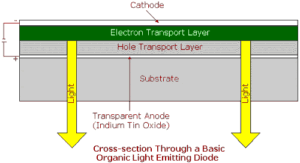In light emitting diodes (LEDs) based on inorganic light emitting materials, some of the photons released by the inorganic materials are also reabsorbed by them. In organic light emitting diodes (OLEDs), which produce light using the same electron/hole recombination method as LEDs, the frequencies of light absorbed by the light emitting materials lie mostly outside the visible spectrum, making OLEDs transparent when switched off and highly efficient emitters, and transmitters, of light when switched on.
Using a control voltage of just 5V an OLED a few millimetres thick can potentially output up to 40 lumens per Watt, as much as a fluorescent tube. Organic materials exist which emit red, green, blue and white light, allowing several approaches to full-colour display production and the devices also have an extremely fast response time (less than a millisecond), making them suitable for displaying video. Along with these desirable attributes go the advantages of wide viewing angles, light weight, simple construction and, consequently, low production costs. OLEDs are the most promising new FPD technology.
OLEDs are classified according to the size of molecules which make up the materials of which they are composed, so there are small molecule OLEDs and large molecule (polymer) OLEDs. The large number of companies, well over 50 world-wide, researching both forms of OLED and the wide variety of organic compounds which have suitable properties for use in OLEDs have resulted in a diversity both in device structures and the markets for which they are being developed. OLEDs both rigid and flexible, small and large, for low and high information content displays exist.

